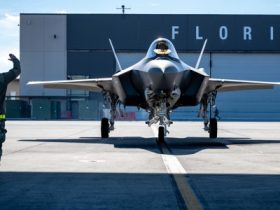This week, Denmark imposed a nationwide ban on all civilian drone flights as European leaders gather in Copenhagen for the European Union Summit. The move follows repeated drone incursions in recent weeks, which Danish authorities have labeled “hybrid attacks,” after sightings of unidentified drones forced airport closures and threatened military sites.
Denmark is far from alone. In recent weeks, NATO fighters scrambled over Poland to intercept 19 Russian drones while another Russian drone loitered in Romanian airspace for nearly an hour. Debris washed ashore in Bulgaria and Latvia, and unidentified drones have also been reported over Germany’s Schleswig-Holstein region, Norway’s main airport, and near a Swedish naval base.
Far from isolated incidents, these incursions reveal a coordinated pattern in a new type of gray zone warfare — what we term “hybrid air denial” — that blurs the lines between peace and war. In this approach, adversaries use low-cost drones to access and deny commercial activity in the air littoral, producing outsized effects on security, the economy and public confidence.
RELATED
Air denial has long been a wartime strategy, relying on fighter patrols, surface-to-air missiles or no-fly zones to contest control of the skies and prevent adversary air forces from operating freely over the battlefield. Recent conflicts, from Ukraine to Armenia-Azerbaijan and Gaza, show that drones, including low-cost systems operating in the air littoral, can extend this strategy to lower altitudes. Now, this approach is increasingly moving into the gray zone, with adversaries leveraging drones to challenge national airspace, test sovereignty and disrupt both civilian and military air operations without triggering full-scale conflict.
What makes drones especially effective for hybrid air denial is their combination of easy access, low cost and minimal perceived risk.
First, drones provide easy access to the air littoral. From commercial to military-grade systems, drones operate at lower altitudes, where the line between the military battlespace and the civilian air traffic system is as blurred as the line between conflict and combat. In these crowded skies, adversaries have persistent opportunities to episodically exploit the air littoral.
Second, drones can generate disproportionate effects at low cost. They are inexpensive, especially compared with the costs of intercepting them. In Polish airspace, for example, NATO used missiles costing between $500,000 and $1 million each to shoot down Russian drones worth about $10,000 apiece. A single drone, far cheaper than any modern aircraft, can shut down an airport handling tens of thousands of passengers and millions of dollars of cargo.
Finally, drones offer more reward than risk. Because these systems lack human operators onboard, and are typically unarmed, adversaries can pursue hybrid warfare at lower escalation risks. And since they can deploy off-the-shelf commercial systems, they operate with plausible deniability, making it hard for authorities to determine ownership and hold the perpetrators accountable.
Put differently, hybrid air denial flips the risk onto the target country: Either let drones fly, effectively ceding control of the air littoral through inaction, or attempt to shoot them down and risk collateral damage, including ground casualties, as a consequence of taking action.
Through hybrid air denial, adversaries demonstrate that the target government cannot fully secure and control its airspace, creating outsized effects that extend far beyond the immediate physical threat. In wartime, drones can disrupt operations and complicate military logistics; in peacetime, they can paralyze commerce and instill fear in populations — and even inspire copycat disruptions that multiply the effect.
Travelers, pilots and citizens are left uncertain about the safety of the skies. Every incursion forces governments to explain their inability to prevent such disruptions, eroding trust in institutions. Airport shutdowns divert flights, delay commerce and ripple through supply chains, all at staggering financial cost. Through these low-cost tactics, adversaries can achieve strategic impact at a fraction of the price that NATO countries spend on air defense and air traffic control.
Responding to this challenge will not be easy. Conventional military defenses were designed to counter high-end aircraft and missiles, not drones blending into or penetrating civilian airspace. Likewise, civil aviation authorities must contend with threats that straddle regulatory and military domains. And this is not just Europe’s problem — China routinely employs similar tactics against Taiwan, Japan and other neighbors in the Indo-Pacific. The United States should take note: These events expose vulnerabilities that exist at home as well.
To address this threat, the United States should ensure Golden Dome’s nationwide coverage has a particular counter-drone focus on civilian airports and other critical infrastructure. Extending coverage beyond military sites to commercial hubs and urban centers will deny adversaries the ability to exploit gaps in U.S. defenses, thereby reducing disruptions to air traffic, commerce, and public confidence. This cannot be done with costly, exquisite systems. Instead, the United States needs low-cost, persistently deployed countermeasures to defend the air littoral at scale.
In the 21st century, denying the air does not always mean shooting down fighters or bombers. It can mean sending a handful of drones that shut down an economy for a day, spread uncertainty across borders and undermine trust in governments to keep skies safe. Recognizing this strategy for what it is — weaponized disruption — is the first step toward countering it.
Maximilian K. Bremer is a retired U.S. Air Force colonel, a nonresident fellow with the Reimagining U.S. Grand Strategy Program at the Stimson Center and head of Mission Engineering and Strategy for Atropos Group.
Kelly A. Grieco is a senior fellow with the Reimagining U.S. Grand Strategy Program at the Stimson Center and an adjunct professor in the Center for Security Studies at Georgetown University.
Read the full article here








Leave a Reply